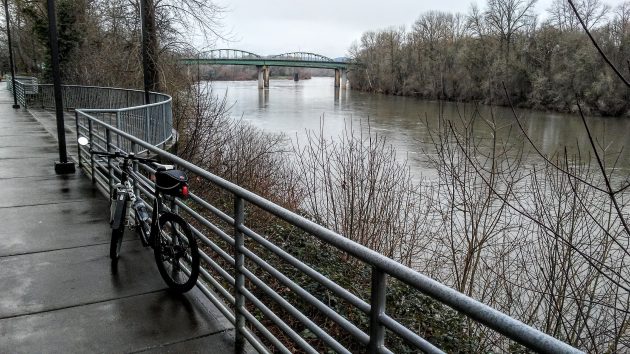
On a gray Saturday afternoon, the Willamette River flows through Albany on Jan. 30.
We’re supposed to be concerned about — or at least interested in — the water quality in our rivers. But if you’re looking for up-to-date summaries on the Willamette from the Oregon DEQ, you’re out of luck.
At the moment, in mid-winter with the river running high and muddy, the water’s quality may be of secondary interest. But come summer, boaters will again be all over the river and bathers will cavort in the shallows at the riverside parks. What can we tell them about the water in which they are playing?
On the website of the Department of Environmental Quality, you can find a report card on the health of the Willamette River.
The report card was assembled by the Fred Meyer Memorial Trust, and it’s kind of reassuring. Based on numerous categories from fish and temperature to flow and water quality, the river is said to rate a B in the upper river to Albany, and also along the middle stretch from Albany to Newberg. From Newberg to the Columbia, it’s rated C+.
That sounds pretty good. The trouble is that the report card, even though it appears on the DEQ site now, is based on information from 2015.
This Jan. 19, the DEQ issued a statement that the levels of pesticide residues in several Oregon watersheds had shown a drop over the years. The report was based on data from 2017-19, but its main shortcoming as far as the mid-valley is concerned is that the Willamette was not part of the study.
What prompted me to think about this was a question from a reader, who wondered about the manhole covers in Albany with the design of a salmon on them. These covers have been around for a number of years and are supposed to remind us that what we put down the drain ends up, in one form or another, in the river.
That’s a useful reminder. But we could also use more timely information about water quality during the recreation season.
Think about this: If you get blood drawn at your local Good Samaritan lab in the morning, they send you the results on dozens of different items by that afternoon. Maybe it would not be too much to ask to have our main waterways monitored more often and the results posted online in a timely way.
Then, information about water quality would be useful to boaters and swimmers before they get wet. (hh)

I wonder what happened to ZAPS technology, Corvallis, which did water quality monitoring in real time and had a test station set up in the Albany water treatment plant?
The internet says they are permanently closed. It was some cool looking tech.
The biggest difference I can see between reporting on blood work and river water is simple. One is done by and efficient entity the other by an inefficient one.
Excessive water quality monitoring sounds an awful lot like government overreach
We can’t let the government keep our waterways clean. That would infringe on our right to pollute them!
At a some of the boards and committees I have been on I have been told that water testing, beyond a few common tests such as nitrate and pH are. are expensive. Lab folks have to know what chemical or pesticide they are looking for to pick the right reactant. With many of the solutions we use on our fields one would drown fom the water in the delution before they chemical would hurt a person or non-targeted plant or wildlife. Beyond this I am probably over my solid knowledge.
Pesticide detections are probably going down because long-lived pesticides are being phased out and mostly only new ones with short half lifes are given labels by the EPA. In farmer language
the effective life is shorter but the potential harmful life is also shorter. That is, the chemicals break down faster.
I know nothing about statistics, but samples from smaller streams would seem to be more accurate than those from large rivers. Mother nature doesn’t hold still for samples and tests and a water sample is just a point in time and place.
The adage that “The solution to pollution is dilution” is not without some truth.